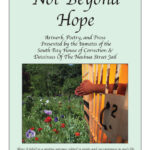
Not Beyond Hope – Fall 2007
September 22, 2007
Not Beyond Hope – Fall 2009
September 22, 2009By Andrea J. Cabral
Sheriff, Suffolk County Sheriff’s Department
November 7, 2007
In a fear–weary nation where we daily face one dire prediction after another, I am loathe to use extremes to describe any problem. Unfortunately, truancy and dropout rates in Boston merit use of the dreaded descriptor: crisis.
This is not a problem the school system can solve or should have to resolve on its own. There is no question that public school education needs solid reform. Overcrowded classrooms, the shortage of good teachers, outdated curricula and the often suffocating effect of the MCAS on more innovative and creative course work are just some of the issues that require internal change. But the roots of the truancy problem are deeply embedded in what happens to kids when they are outside of the classroom – on the street and, most importantly, in their homes. When it comes to education, too many kids are under–parented or not being parented at all. Schools do not keep truancy a secret from parents. They receive notices, get phone calls, e–mails, invitations to parent–teachers meetings; students receive reports cards with poor grades and schools send written warnings of impending failure to graduate. Education doesn’t just happen because schools and teachers exist. Parents must demand quality education from their schools, but they must also support, encourage and nurture education in their homes. The frequently truant child is a neglected child. Frequent truancy means that, for whatever reason, no one at home is regularly reviewing homework or school projects, checking grades and attendance or staying in touch with teachers. Any parent who buys a Sony PlayStation but not a computer for their child just doesn’t get it. The Suffolk County House of Correction is full of young men who can play video games masterfully, but can’t read, comprehend or write well.
Because the vast majority of affected students in Boston are Black and Latino, many are afraid to have a candid discussion about the crucial role and responsibility of parents. Whites fear being accused of racism, Blacks and Latinos fear that real issues of disparate resources and race–based historical inequities will be ignored in a rush to shift blame. I can’t afford to be afraid. Today, my facilities are full of yesterday’s truant children who dropped out. Tomorrow, more will re–enter Suffolk County’s communities, unemployed adults with no money and no stable address. Fear of what might happen is hardly reason to avoid dealing honestly with what is actually happening. We face an epidemic of poor households headed by single, young women of color, many of whom are undereducated or uneducated and there is an inexplicable increasing community acceptance of this family dynamic. We need to confront this and then act to change this dynamic and all the reasons for it.
There’s a lot we can do right now. Last month, I held a forum on truancy at Roxbury Community College. The panelists were all stakeholders ready to commit time and combine resources to create effective partnerships with the Boston public school system. We can work with existing truancy programs and create a comprehensive, system–wide program that is sustainable. Alan Khazei, co–founder of City Year and David Shapiro, CEO of the Mass Mentoring Partnership want to make youth mentors part of mainstream middle and high school student life. Community–based efforts like the Truancy Taskforce led by Representative Liz Malia can provide crucial data and support from grassroots volunteers. Representative Malia and her colleagues can ensure sustainability with good legislation.
My department has the Choice Program, comprised of a trained cadre of corrections officers who make multiple visits to Boston schools, grades five through nine. These officers teach from an approved curriculum that cautions students on the dangers of drug use and gang involvement and encourages them to make good choices and show respect for themselves and others. The response to this program from students and teachers has been overwhelming. This year we added a section on civics to the curriculum. Sheriffs’ deputies can also work as truant officers.
Another panelist, my colleague Sheriff Carmen Massimiano, operates a Juvenile Resource Center in Berkshire County that is seeing remarkable success. Sheriff Massimiano, who at the time was both Sheriff and a member of the School Committee, could see the clear connection between truancy, delinquency and escalating criminal behavior. He converted a vacant jail into a truancy center and created a partnership between the school district, the Juvenile Courts, the Sheriff’s Department and social services. Together, they use the Resource Center to rescue truant kids from the street, bring them up to speed on their class work and mainstream them back into school. The courts ensure parental accountability and social services provide assistance with problems at home that cause problems at school. A program like that could work in Boston.
I devote a substantial portion of my budget and staff resources to inmate educational, vocational, substance abuse and reentry programs. In the past two years in just one of our programs, The Common Ground Institute, we have educated and trained some 270 inmates in marketable vocational skills and found jobs for 90 of them with employers who know they have criminal histories. These programs increase opportunity and self–esteem, they reduce recidivism and I will continue to keep them viable and effective. The problem is no one should have to come to jail before they get an education or find a job, particularly when it costs over $30,000 per year, per inmate to house them. Back–end solutions are much better than nothing, but the state where public education began can do much better. We should be willing to invest at least as much time and money to educate our children before they commit crimes, when the choice is ours, as we are afterward, when the choice is theirs and we can only hope and pray they make the right one.



